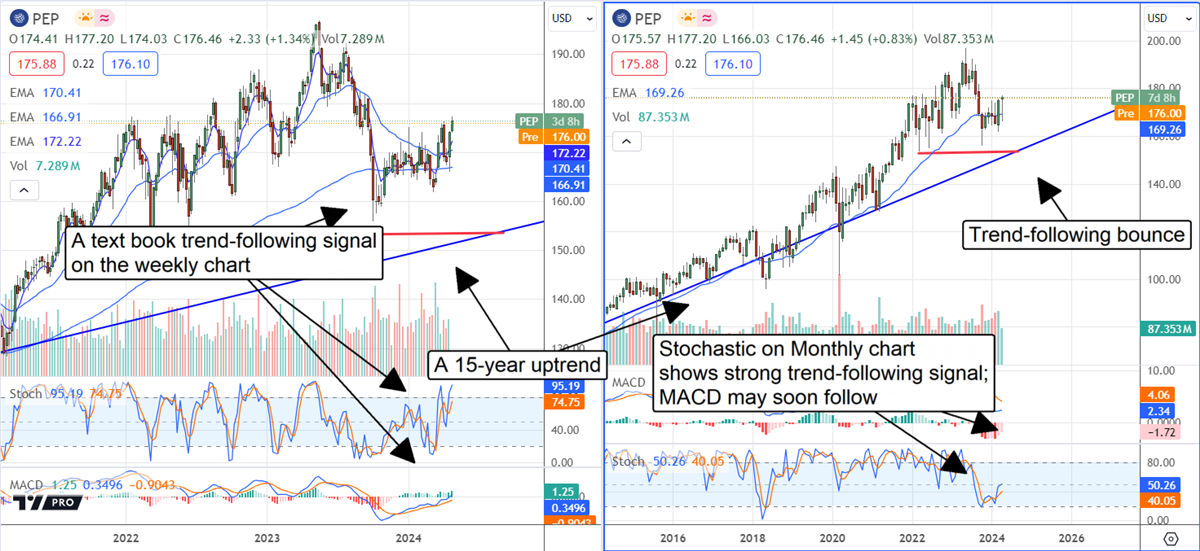
Consumer staples and Dividend Kings like PepsiCo (NASDAQ: PEP) are not often stocks that provide a lot of PEP for a portfolio. However, they can deliver substantial, market-beating returns when the stars align. Regarding PepsiCo, this blue-chip, industry-leading, undervalued, high-yielding consumer-focused company is amid a leveraged rebound, which is shown in the charts. The charts show a solid trend-following signal that could soon take the market to a new all-time high.
That outlook is affirmed by the analysts who’ve revised their ratings enough in the last six months to lift the stock’s consensus rating from Hold to Buy and keep the price target steady. The two freshest revisions, issued only weeks before the Q1 earnings release, include two upward price target revisions and the new high target among analysts. That is $209, a new all-time high when reached.
PepsiCo had a Strong Quarter Despite Headwinds
[content-module:CompanyOverview|NASDAQ: PEP]
PepsiCo’s Q1 was solid, given the tough comps to last year, inflationary and consumer headwinds, and a recall of Quaker products that included cereals, bars, and snacks. The impact of the recall is reported at nearly 100 basis points of reported revenue, enough to double the reported outperformance relative to analysts' consensus estimates. PepsiCo reported $18.25 billion in net revenue for a gain of 2.3%, which outpaced consensus by 80 bps. Volume fell by 0.5% but is offset by price and mix.
Quaker is the sole weak spot segmentally, down -24% compared to last year, but tough comps are also in play. Latin America is the strongest segment, with 16% GAAP and 8% organic growth, excluding the impact of FX conversion. Latin America is now the 3rd largest segment by sales. APAC grew 11%, Europe 10%, and AMESA 7%. Domestic segments PepsiCo NA and Frito Lay NA grew by 1% and 2%, highlighting the effectiveness of PepsiCo’s diversification and international growth strategy.
Margin news is another area of strength. The company widened the net income margin by 35 basis points to leverage bottom-line growth. The GAAP EPS of $1.48 grew by 6% to more than double the top-line advance, while adjusted earnings of $1.61 are up 7%. Adjusted earnings outpaced the consensus estimate reported by Marketbeat by $0.09 or 590 bps and led the company to affirm its guidance. PepsiCo reaffirmed the outlook for 4% or better organic growth compared to the 3.5% consensus and for EPS to grow by at least 8%.
PepsiCo Capital Returns are Healthy
[content-module:DividendStats|NASDAQ: PEP]
PepsiCo’s dividend is near the high end of its historic range, with shares down from their highs, but the yield may not last long. The payment is worth nearly 3% at current prices and is healthy, safe, and reliable. Not only is PepsiCo a Dividend King with a track record of increases, but its financial metrics are solid. Q1 operations included a sequential cash draw, but operations over the last year resulted in nearly doubling cash, reduced total liabilities, and a 2.9% increase in shareholder equity. Better results are expected this year.
The dividend payment is about 65%, on the high side for safety, but backed up by earnings growth. The projected distribution payment for 2024 is for a 7% increase starting in June, less than the 8% minimum earnings growth, and that does not include the impact of share repurchases. PepsiCo does not repurchase aggressively but enough to offset share-based compensation; the count is down an average of 0.3% YOY at the end of Q1.
PepsiCo Steady After Solid Results
PepsiCo's price action is steady and edging higher following the Q1 results and guidance update. The move aligns with recent action, suggesting a trend-following signal is in play. The market shows a bottom at $160, which is above the prior low and the long-term up-trend line that has been in play for fifteen years. The MACD and stochastic Indicators confirm the signal, showing solid buy signals of their own, and have ample room to move higher. Assuming the market follows through on this signal, PEP stock should advance over the next few quarters and could retest all-time highs by the end of the year.







